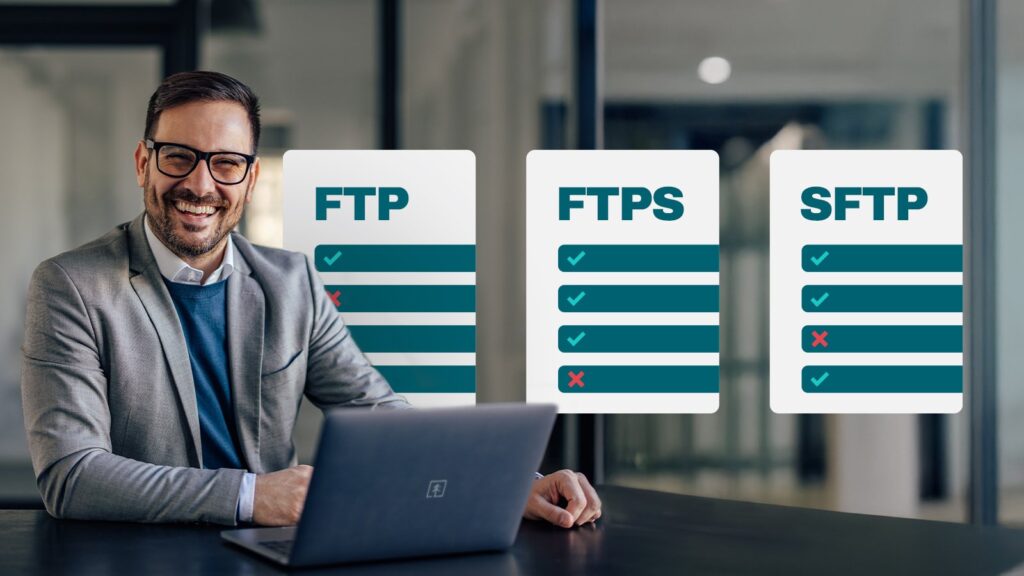Category: FTP
-

How to transfer and download files using FTP
Learn how to download from FTP using graphical clients or the command line. Understand your options and explore secure alternatives like SFTP,…
Learn More
-

How to set up an FTP scheduler for windows
Scheduled file transfers offer significant operational, strategic and technical benefits. They allow your IT staff to save time and improve productivity. They…
Learn More
-

What is an FTP site?
An FTP site is a server that enables you to upload and dropdown#toggle” data-dropdown-placement-param=”top” data-term-id=”292785099″>File Transfer Protocol (FTP). Many people use FTP…
Learn More
-

AS2 vs SFTP—What’s the difference?
AS2, used for direct B2B exchanges like EDI over HTTP/S, emphasizes encryption, authentication, and non-repudiation with MDN receipts. SFTP, functioning over SSH,…
Learn More
-

SFTP vs. MFT: Benefits of an MFT solution
When you first start identifying the right file transfer solution for your organization, you’ll encounter these two acronyms: MFT and SFTP. SFTP…
Learn More
-

Tutorial for working with the FTP command line
This tutorial is for those who 1) understand the vulnerabilities of FTP but still want to learn how it’s used AND 2)…
Learn More
-

Active vs. passive FTP simplified
dropdown#toggle” data-dropdown-placement-param=”top” data-term-id=”295410482″>File Transfer Protocol (FTP) server runs behind a dropdown#toggle” data-dropdown-placement-param=”top” data-term-id=”295410497″>router, your users may sometimes encounter connectivity issues. One of…
Learn More
-

Protecting your file transfer service from internal threats
Overview [Last updated: December 2020] Malicious insiders and careless insiders are increasingly posing serious risks to file transfer systems. If nothing is…
Learn More
-

FTP binary and ASCII transfer types and the case of corrupt files
When transferring files through the File Transfer Protocol (FTP), you sometimes need to pay attention to the type of file you transfer…
Learn More
-

Understanding key differences between FTP, FTPS and SFTP
When it comes to moving files across networks, not many protocols are as established as File Transfer Protocol (FTP), File Transfer Protocol…
Learn More
-

Excluding passive IP for internal FTP/S connections to your reverse proxy
Overview Last time, we tackled the problem system administrators encounter when their passive FTP or FTPS connections have to pass through a…
Learn More
-

Setting up an FTPS server behind a firewall or NAT for PASV mode data transfers
It’s never easy to set up an FTP server the moment firewalls get involved. But it gets even more complicated once you…
Learn More
-

What is the FTP/S EPSV command and when do you use it?
EPSV is a command issued by an FTP/S client to signal the server that it wishes to enter into what is known…
Learn More
-

Setting up a trading partner for automated FTP/S
Overview As explained in the first section of the article Preparing Trading Partner Servers For SFTP Automation, the process of establishing an…
Learn More
-

Choosing between SSL implicit, explicit, and forced explicit modes
Overview There will be times when you’ll want to transfer files over a secure connection. One option is to use FTPS (FTP…
Learn More
-

Drawbacks of the 4 most popular file transfer methods
This post was originally published on June 2013 but was last updated on August 16, 2018. Overview Sending someone multi-megabyte or even…
Learn More
-

How to do SSL file transfers on JSCAPE MFT server
Overview In one of my previous posts, I defined what an SSL file transfer is. Today, I’m going to show you how…
Learn More
-

Setting up a linux FTP server – part 3
This is Part 3 of our 3-part blog post showing how to set up a Linux FTP Server. Let’s recap what we’ve…
Learn More
-

Setting up a linux FTP server – part 2
For those who landed on this page via the search engines, this post is a continuation of our article re Setting up…
Learn More
-

Setting up a linux FTP server – part 1 | JSCAPE MFT server
Overview on Setting Up a Linux FTP Server In this post, I’ll show you how easy it is to set up a Linux…
Learn More
-

Video: how to automatically forward files from FTP to SFTP
In this video tutorial, we’ll show you how to automatically forward FTP uploads to an SFTP server.
Learn More
-

Updated video: how to add and manage file transfer services
This video tutorial demonstrates how to add and manage file transfer services like FTP, FTPS, SFTP, HTTP, HTTPS, AS2, OFTP, TFTP, AFTP,…
Learn More
-

Using windows FTP scripts to automate file transfers
Before they discovered managed file transfer (MFT), many Microsoft-oriented customers relied on Windows File Transfer Protocol (FTP) scripts to automate their file…
Learn More
-

Top 5 FTP alternatives for businesses
Overview In our last post, we talked about the importance of applying the CIA Triad to enterprise file transfers. Interestingly, one of…
Learn More
-

Mapping FTP, FTPS, or SFTP server drives to samba
Overview There are a couple of reasons why you’ll want to map file transfer server drives to Samba shares. Maybe your users…
Learn More
-

EDI transmission types every trading partner should know
Overview In order to conduct Electronic Data Interchange (EDI) transactions with a trading partner, businesses need a way of transmitting their EDI…
Learn More
-

How to use a windows FTP client for secure downloads
Despite FTP’s vulnerabilities, many Windows users still use FTP clients for transferring files over the Internet. If you really have to keep…
Learn More
-

Demystifying SMTP ports: when to use port 25, 587, 465 or 2525
When you’re tasked with configuring Simple Mail Transfer Protocol (SMTP) settings to connect to an email server, you need to get two…
Learn More
-

Forwarding files from FTP to an SFTP server with JSCAPE
JSCAPE is pleased to announce the release of AnyClient 4.2. This release includes several new features and enhancements, highlights of which include:
Learn More
-

FTP automation without using scripts
Overview FTP automation is usually achieved by employing scripts or batch files. There’s an easier way to do it.
Learn More
-

SMTP vs IMAP vs POP3 – knowing the difference
Overview Your ability to send and receive emails is largely due to 3 TCP protocols: SMTP, IMAP, and POP3. If you’ve got…
Learn More
-

Can you identify the port numbers of these 12 file transfer protocols?
Most of these file transfer protocols should already be running on your network. Can you identify their respective default port numbers?
Learn More
-

Moving files on the remote server after an automated FTP download
Overview A couple of weeks ago, I received another interesting query from one of our customers. He was setting up an automated…
Learn More
-

How to send large files over the internet
Overview In this post, we’ll talk about the best options for sending large files over the Internet. We’ll discuss which scenarios each…
Learn More
-

SFTP simplified
Overview SFTP is a secure method for transferring files between two computers. SFTP can stand for either SSH File Transfer Protocol or…
Learn More
-

Redefining the FTP server
Overview Your perception of an FTP server may be in need of an overhaul and you probably need to know why.
Learn More
-

Laws that could impact your choice of file transfer software
Overview Choosing a file transfer software might seem like a trivial exercise. Any application capable of delivering files to your intended recipient…
Learn More
-

How to achieve truly secure FTP — 7 essential tips | JSACPE
Although plain File Transfer Protocol (FTP) has been the data transfer solution of choice for several decades, it’s no longer fit for…
Learn More
-

How to prevent sniffer attacks with encrypted FTP
Overview A lot of people who often send files love FTP. The File Transfer Protocol allows users to transmit volumes of files…
Learn More
-

What to consider when setting up DMZ’s reverse proxy & firewall
There are a number of things to consider when setting up the reverse proxy and firewalls in your DMZ. These things are…
Learn More
-

AnyClient web offers online FTP client
JSCAPE is pleased to announce the release of AnyClient Web, an intuitive web based file transfer client available for Windows, Mac OS…
Learn More
-

AnyClient 4.1 released – free FTP client
JSCAPE is pleased to announce the release of AnyClient 4.1.
Learn More
-

Guide to HIPAA compliant file transfers – part 2
Guide to HIPAA Compliant File Transfers – Part 1 In this post, we’ll be talking about the specific standards that lead to…
Learn More
-

A guide to HIPAA compliant file transfers – part 1
For some entities in the health care industry, file transfer activities are no longer as simple as before. Measures have to be…
Learn More
-

Secure file transfer with java FTP library
When two little kids want to exchange a secret, a lot of negotiation is necessary: “Promise you won’t tell? Cross your heart…
Learn More
-

How to transfer files with the java FTP library
Here’s some philosophy to go with the Secure FTP Factory library. There are some things in life that you should never do…
Learn More
Browse by category
-
(23)
-
(43)
-
(7)
-
(38)
-
(57)
-
(40)
-
(19)
-
(622)
-
(3)
-
(390)
-
(106)
-
(5)
-
(19)
-
(199)
-
(22)
-
(86)




